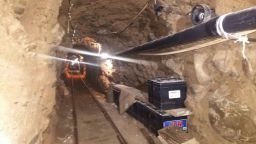Story highlights
'Super tunnel' with rail system stretched for eight football fields between Tijuana, San Diego
Authorities also seize at least 12 tons of marijuana with street value of $6 million
Smugglers on the U.S.-Mexico border have become so sophisticated in moving drugs that one “super tunnel” raided this week featured a railway.
The tunnel stretched the length of eight football fields, from a Tijuana warehouse to a San Diego warehouse, and had a rail system, lighting, electricity, and metal beams to prevent a cave-in.
Authorities confiscated at least 12 tons of marijuana with a street value of $6 million and arrested 22 people in San Diego and Tijuana in connection with the one of the largest tunnels uncovered in recent years.
“We see a super tunnel open for business once every year or so,” U.S. Attorney Laura Duffy of Southern California said in a statement. “Just when traffickers think they’re ready to move, we put them out of business.”
The newly constructed tunnel was discovered as part of a six-month investigation that began last May and involved an undercover agent who helped transport buckets filled with dirt from the tunnel warehouse and then offered to transport and store drugs for the defendants, authorities said.

The San Diego end of the tunnel is located just a half-mile from the Otay Mesa border crossing.
On Wednesday, the defendants told the undercover agent about moving loads of marijuana from the tunnel warehouse to another warehouse. Authorities believe this would have been the first time that a significant amount of drugs would have been moved through the tunnel.
But by Wednesday night, authorities seized control of the “sophisticated cross-border super tunnel,” authorities said in a press release.
The tunnel is the tenth large-scale drug smuggling tunnel discovered in the San Diego area since 2006. In all, authorities have found more than 75 cross-border smuggling tunnels, mostly in California and Arizona, prosecutors said.
Man smuggles cocaine between U.S. and Mexico through underwater tunnel
CNN’s Seth Kovar contributed to this report.
































